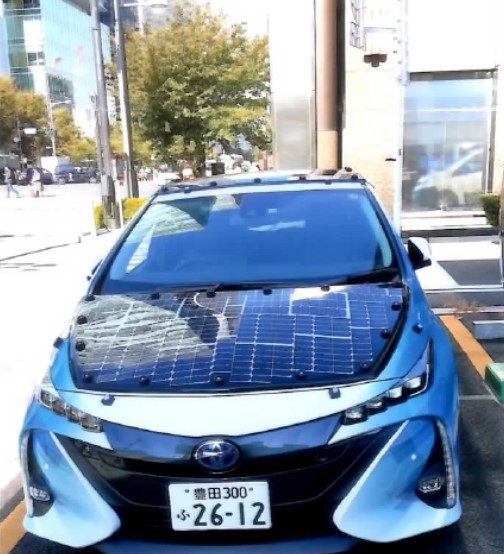Researchers from Japanese carmaker Toyota Motor Corporation, electronics manufacturer Sharp and the New Energy and Industrial Technology Development Organization of Japan (NEDO) have assessed the technical potential of applying solar cells based on gallium arsenide (GaAs) and other III-V materials to passenger cars that are partially powered by PV.
GaAs and III-V solar cells are among the best known in terms of efficiency potential but cost has thus far limited them to niche applications such as powering satellites and drones.
In the study Development of high‐efficiency and low‐cost solar cells for PV‐powered vehicles application, published in Progress in Photovoltaics, the scientists say this niche market may potentially reach a global cumulative installed PV capacity of 50 GW by 2030 and 0.4 TW by 2040. “When the 70% of the annual sold passenger cars are equipped with the 1 kW rated-power PV module, the potential of the annual market size is calculated to be 50 GW/year,” the researchers explained.
Solar cells with efficiencies higher than 30%, including multijunction III-V cells and III-V cells combined with silicon cells, are the best candidates for applications in the automotive sector due to the limited space of electric car rooftops, the study found. The scientists acknowledge, however, that these devices are still too costly and that further improvements in material and cell quality, as well as reduction in resistance loss, should be achieved.
Technical improvements include reduction in film thickness, a high growth rate of films, reuse of substrates and silicon tandem solar cells and, most importantly, the achievement of economies of scale in mass production, the Japanese group said. “The results suggest that there are many possible ways to achieve $10/W for III-V-based solar cell modules, such as scaling up production volume to 10MW/year with a high-speed growth method, or using silicon substrate instead of expensive gallium arsenide or germanium substrate,” it explained.
High-speed deposition (H-VPE) is indicated as a way to reduce deposition costs for III-V materials without sacrificing performance significantly. “H-VPE uses elemental group III's, eliminating the processing needed to form metal organics and enabling up to 10 times reduction in group-III input cost,” the researchers stated. “H-VPE also provides higher throughput, with demonstrated gallium arsenide growth rates up to 300μm/h as well as improved reactant utilization.” Challenges remain in the development of abrupt and defect-free hetero-interfaces, however, and further studies are necessary to improve resistance loss, external radiative efficiency and the understanding of bulk and interface recombination, they added.
As for the III-V tandem cells based on silicon, the researchers said that these could have significant future potential for automotive applications due to efficiencies that can be higher than 40% and their light weight and low cost.
The study also briefly presents the results of the application of Sharp's high‐efficiency III‐V triple‐junction solar cell modules with an output power of 860 W to a Toyota Prius PHV. The triple‐junction solar cell modules with efficiency of 32.84% are based on indium gallium phosphide (InGaP), gallium arsenide (GaAs) and indium gallium arsenide (InGaAs).
This content is protected by copyright and may not be reused. If you want to cooperate with us and would like to reuse some of our content, please contact: editors@pv-magazine.com.




4 comments
By submitting this form you agree to pv magazine using your data for the purposes of publishing your comment.
Your personal data will only be disclosed or otherwise transmitted to third parties for the purposes of spam filtering or if this is necessary for technical maintenance of the website. Any other transfer to third parties will not take place unless this is justified on the basis of applicable data protection regulations or if pv magazine is legally obliged to do so.
You may revoke this consent at any time with effect for the future, in which case your personal data will be deleted immediately. Otherwise, your data will be deleted if pv magazine has processed your request or the purpose of data storage is fulfilled.
Further information on data privacy can be found in our Data Protection Policy.